World Health Organization: Strategic Analysis and Environmental Impact
VerifiedAdded on 2020/12/10
|17
|5961
|322
Report
AI Summary
This report provides an in-depth analysis of the World Health Organization (WHO), examining its various strategic approaches, including intended, emergent, and umbrella strategies. It explores the roles of environmental analysis, particularly PEST analysis, in understanding the external factors that impact WHO's operations and strategic planning. The report differentiates between these strategies with examples and suggests improvements for strategy implementation within the organization. The analysis considers the implications of environmental factors on a country's future health, emphasizing the importance of adapting strategies to address evolving challenges and opportunities in global health. The report also covers the significance of strategy for the organization and the importance of environmental analysis in the healthcare sector.
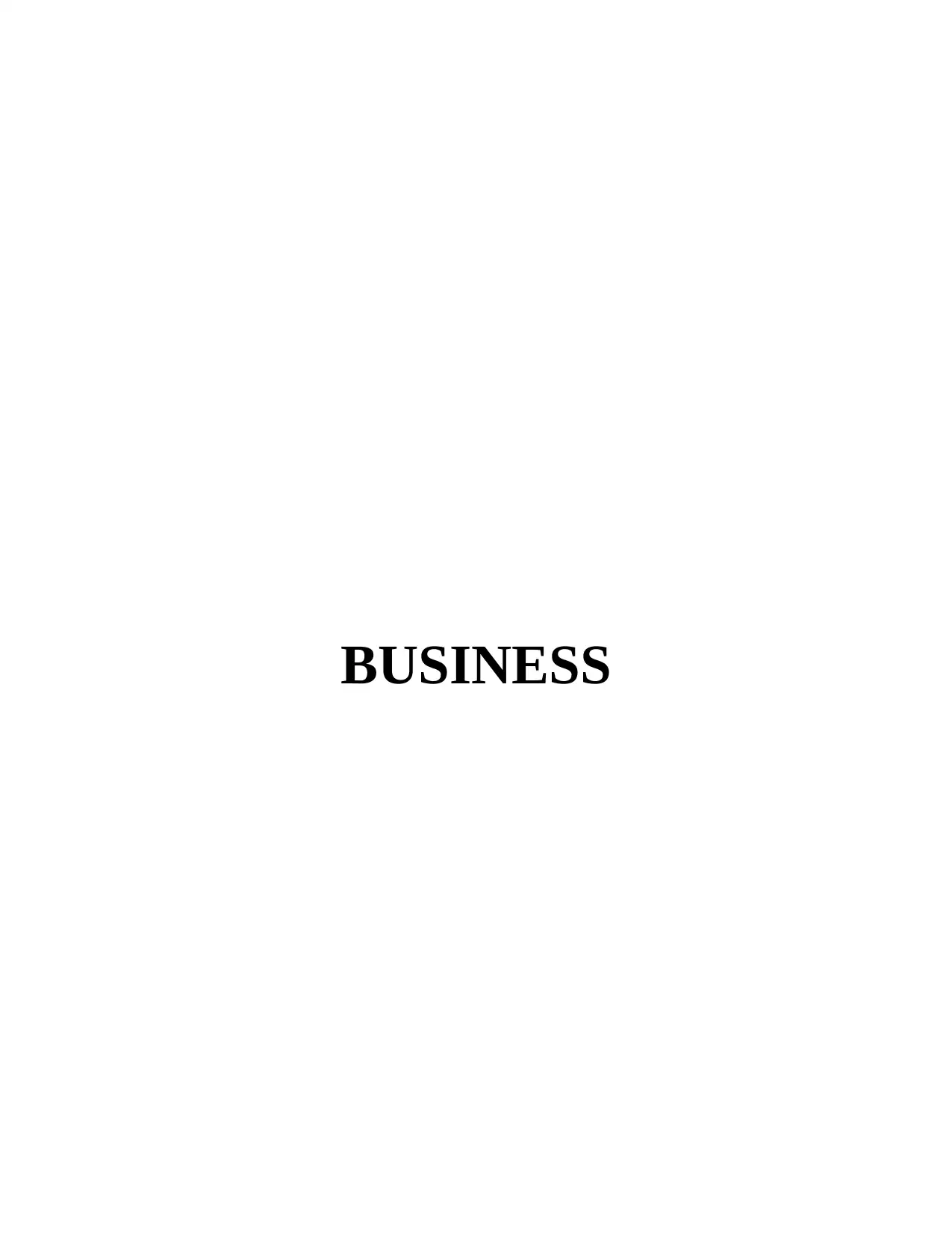
BUSINESS
Paraphrase This Document
Need a fresh take? Get an instant paraphrase of this document with our AI Paraphraser
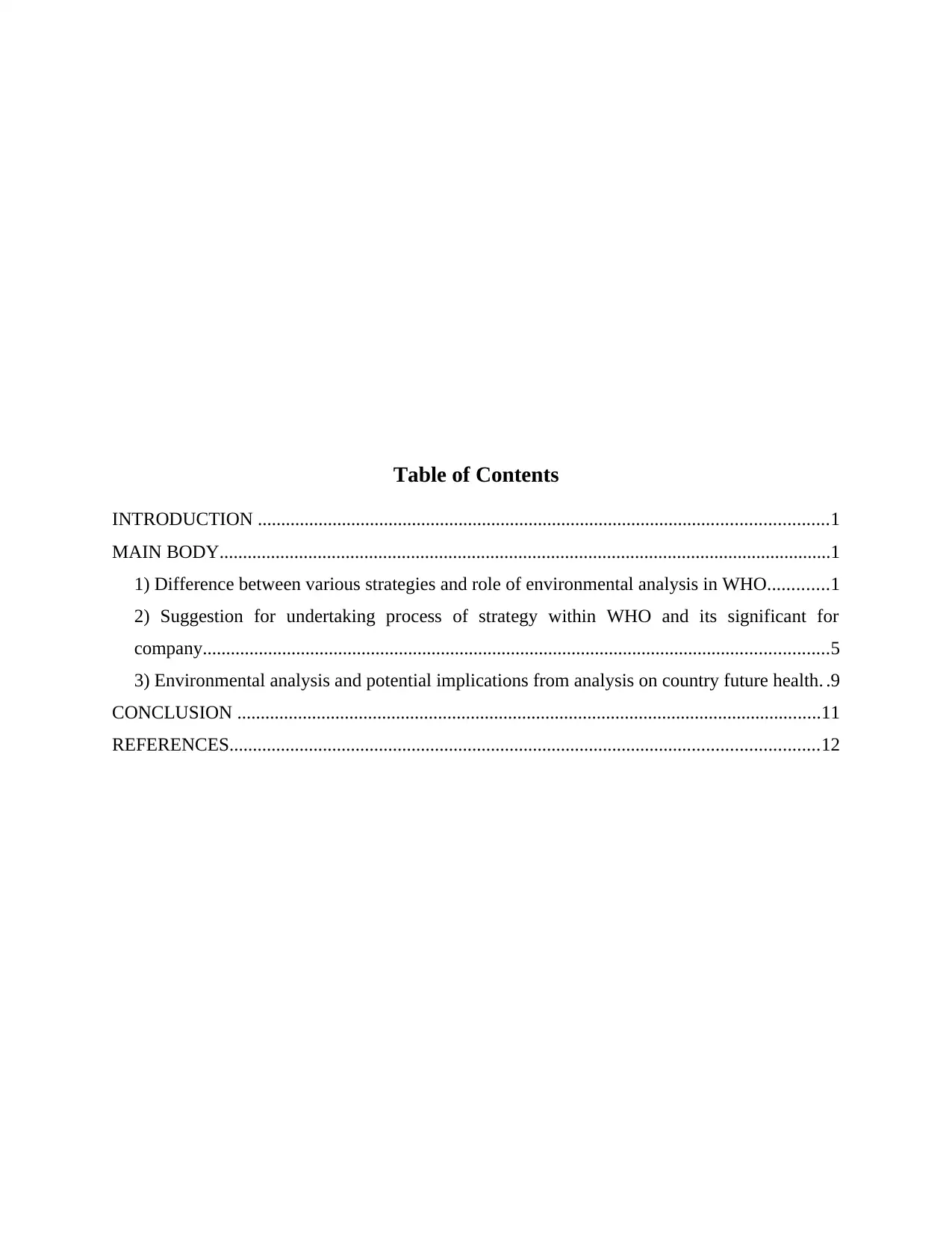
Table of Contents
INTRODUCTION ..........................................................................................................................1
MAIN BODY...................................................................................................................................1
1) Difference between various strategies and role of environmental analysis in WHO.............1
2) Suggestion for undertaking process of strategy within WHO and its significant for
company......................................................................................................................................5
3) Environmental analysis and potential implications from analysis on country future health. .9
CONCLUSION .............................................................................................................................11
REFERENCES..............................................................................................................................12
INTRODUCTION ..........................................................................................................................1
MAIN BODY...................................................................................................................................1
1) Difference between various strategies and role of environmental analysis in WHO.............1
2) Suggestion for undertaking process of strategy within WHO and its significant for
company......................................................................................................................................5
3) Environmental analysis and potential implications from analysis on country future health. .9
CONCLUSION .............................................................................................................................11
REFERENCES..............................................................................................................................12
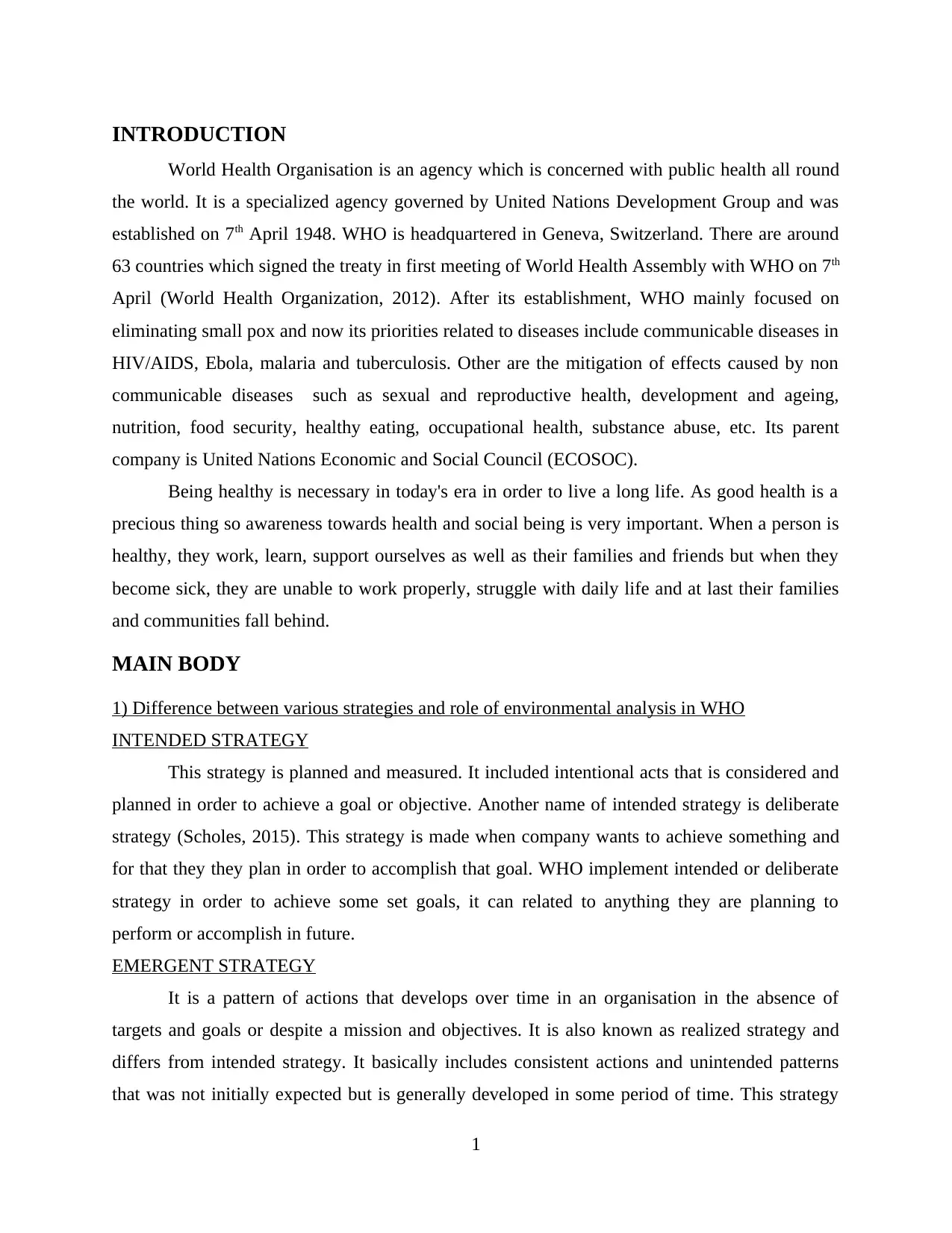
INTRODUCTION
World Health Organisation is an agency which is concerned with public health all round
the world. It is a specialized agency governed by United Nations Development Group and was
established on 7th April 1948. WHO is headquartered in Geneva, Switzerland. There are around
63 countries which signed the treaty in first meeting of World Health Assembly with WHO on 7th
April (World Health Organization, 2012). After its establishment, WHO mainly focused on
eliminating small pox and now its priorities related to diseases include communicable diseases in
HIV/AIDS, Ebola, malaria and tuberculosis. Other are the mitigation of effects caused by non
communicable diseases such as sexual and reproductive health, development and ageing,
nutrition, food security, healthy eating, occupational health, substance abuse, etc. Its parent
company is United Nations Economic and Social Council (ECOSOC).
Being healthy is necessary in today's era in order to live a long life. As good health is a
precious thing so awareness towards health and social being is very important. When a person is
healthy, they work, learn, support ourselves as well as their families and friends but when they
become sick, they are unable to work properly, struggle with daily life and at last their families
and communities fall behind.
MAIN BODY
1) Difference between various strategies and role of environmental analysis in WHO
INTENDED STRATEGY
This strategy is planned and measured. It included intentional acts that is considered and
planned in order to achieve a goal or objective. Another name of intended strategy is deliberate
strategy (Scholes, 2015). This strategy is made when company wants to achieve something and
for that they they plan in order to accomplish that goal. WHO implement intended or deliberate
strategy in order to achieve some set goals, it can related to anything they are planning to
perform or accomplish in future.
EMERGENT STRATEGY
It is a pattern of actions that develops over time in an organisation in the absence of
targets and goals or despite a mission and objectives. It is also known as realized strategy and
differs from intended strategy. It basically includes consistent actions and unintended patterns
that was not initially expected but is generally developed in some period of time. This strategy
1
World Health Organisation is an agency which is concerned with public health all round
the world. It is a specialized agency governed by United Nations Development Group and was
established on 7th April 1948. WHO is headquartered in Geneva, Switzerland. There are around
63 countries which signed the treaty in first meeting of World Health Assembly with WHO on 7th
April (World Health Organization, 2012). After its establishment, WHO mainly focused on
eliminating small pox and now its priorities related to diseases include communicable diseases in
HIV/AIDS, Ebola, malaria and tuberculosis. Other are the mitigation of effects caused by non
communicable diseases such as sexual and reproductive health, development and ageing,
nutrition, food security, healthy eating, occupational health, substance abuse, etc. Its parent
company is United Nations Economic and Social Council (ECOSOC).
Being healthy is necessary in today's era in order to live a long life. As good health is a
precious thing so awareness towards health and social being is very important. When a person is
healthy, they work, learn, support ourselves as well as their families and friends but when they
become sick, they are unable to work properly, struggle with daily life and at last their families
and communities fall behind.
MAIN BODY
1) Difference between various strategies and role of environmental analysis in WHO
INTENDED STRATEGY
This strategy is planned and measured. It included intentional acts that is considered and
planned in order to achieve a goal or objective. Another name of intended strategy is deliberate
strategy (Scholes, 2015). This strategy is made when company wants to achieve something and
for that they they plan in order to accomplish that goal. WHO implement intended or deliberate
strategy in order to achieve some set goals, it can related to anything they are planning to
perform or accomplish in future.
EMERGENT STRATEGY
It is a pattern of actions that develops over time in an organisation in the absence of
targets and goals or despite a mission and objectives. It is also known as realized strategy and
differs from intended strategy. It basically includes consistent actions and unintended patterns
that was not initially expected but is generally developed in some period of time. This strategy
1
⊘ This is a preview!⊘
Do you want full access?
Subscribe today to unlock all pages.

Trusted by 1+ million students worldwide
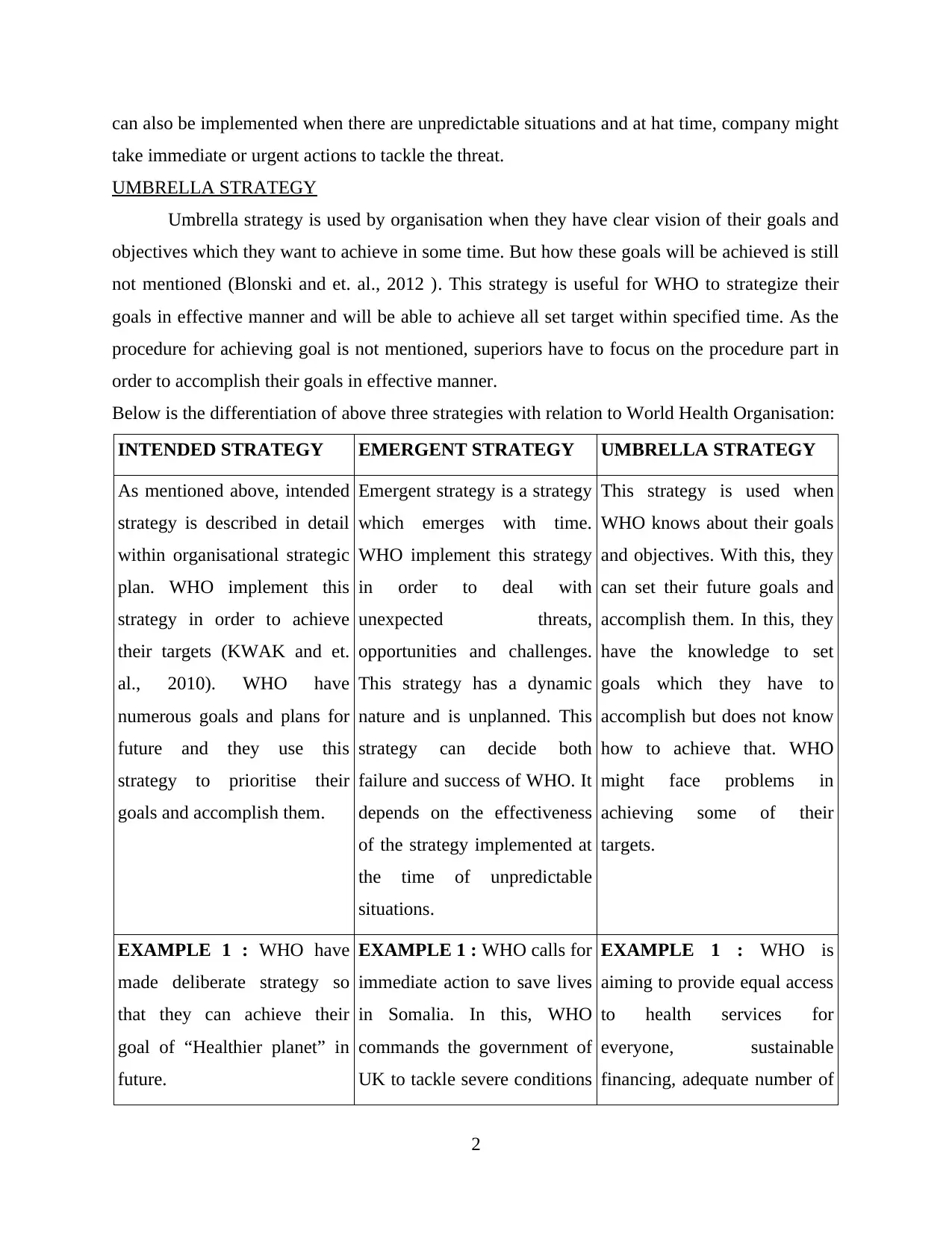
can also be implemented when there are unpredictable situations and at hat time, company might
take immediate or urgent actions to tackle the threat.
UMBRELLA STRATEGY
Umbrella strategy is used by organisation when they have clear vision of their goals and
objectives which they want to achieve in some time. But how these goals will be achieved is still
not mentioned (Blonski and et. al., 2012 ). This strategy is useful for WHO to strategize their
goals in effective manner and will be able to achieve all set target within specified time. As the
procedure for achieving goal is not mentioned, superiors have to focus on the procedure part in
order to accomplish their goals in effective manner.
Below is the differentiation of above three strategies with relation to World Health Organisation:
INTENDED STRATEGY EMERGENT STRATEGY UMBRELLA STRATEGY
As mentioned above, intended
strategy is described in detail
within organisational strategic
plan. WHO implement this
strategy in order to achieve
their targets (KWAK and et.
al., 2010). WHO have
numerous goals and plans for
future and they use this
strategy to prioritise their
goals and accomplish them.
Emergent strategy is a strategy
which emerges with time.
WHO implement this strategy
in order to deal with
unexpected threats,
opportunities and challenges.
This strategy has a dynamic
nature and is unplanned. This
strategy can decide both
failure and success of WHO. It
depends on the effectiveness
of the strategy implemented at
the time of unpredictable
situations.
This strategy is used when
WHO knows about their goals
and objectives. With this, they
can set their future goals and
accomplish them. In this, they
have the knowledge to set
goals which they have to
accomplish but does not know
how to achieve that. WHO
might face problems in
achieving some of their
targets.
EXAMPLE 1 : WHO have
made deliberate strategy so
that they can achieve their
goal of “Healthier planet” in
future.
EXAMPLE 1 : WHO calls for
immediate action to save lives
in Somalia. In this, WHO
commands the government of
UK to tackle severe conditions
EXAMPLE 1 : WHO is
aiming to provide equal access
to health services for
everyone, sustainable
financing, adequate number of
2
take immediate or urgent actions to tackle the threat.
UMBRELLA STRATEGY
Umbrella strategy is used by organisation when they have clear vision of their goals and
objectives which they want to achieve in some time. But how these goals will be achieved is still
not mentioned (Blonski and et. al., 2012 ). This strategy is useful for WHO to strategize their
goals in effective manner and will be able to achieve all set target within specified time. As the
procedure for achieving goal is not mentioned, superiors have to focus on the procedure part in
order to accomplish their goals in effective manner.
Below is the differentiation of above three strategies with relation to World Health Organisation:
INTENDED STRATEGY EMERGENT STRATEGY UMBRELLA STRATEGY
As mentioned above, intended
strategy is described in detail
within organisational strategic
plan. WHO implement this
strategy in order to achieve
their targets (KWAK and et.
al., 2010). WHO have
numerous goals and plans for
future and they use this
strategy to prioritise their
goals and accomplish them.
Emergent strategy is a strategy
which emerges with time.
WHO implement this strategy
in order to deal with
unexpected threats,
opportunities and challenges.
This strategy has a dynamic
nature and is unplanned. This
strategy can decide both
failure and success of WHO. It
depends on the effectiveness
of the strategy implemented at
the time of unpredictable
situations.
This strategy is used when
WHO knows about their goals
and objectives. With this, they
can set their future goals and
accomplish them. In this, they
have the knowledge to set
goals which they have to
accomplish but does not know
how to achieve that. WHO
might face problems in
achieving some of their
targets.
EXAMPLE 1 : WHO have
made deliberate strategy so
that they can achieve their
goal of “Healthier planet” in
future.
EXAMPLE 1 : WHO calls for
immediate action to save lives
in Somalia. In this, WHO
commands the government of
UK to tackle severe conditions
EXAMPLE 1 : WHO is
aiming to provide equal access
to health services for
everyone, sustainable
financing, adequate number of
2
Paraphrase This Document
Need a fresh take? Get an instant paraphrase of this document with our AI Paraphraser
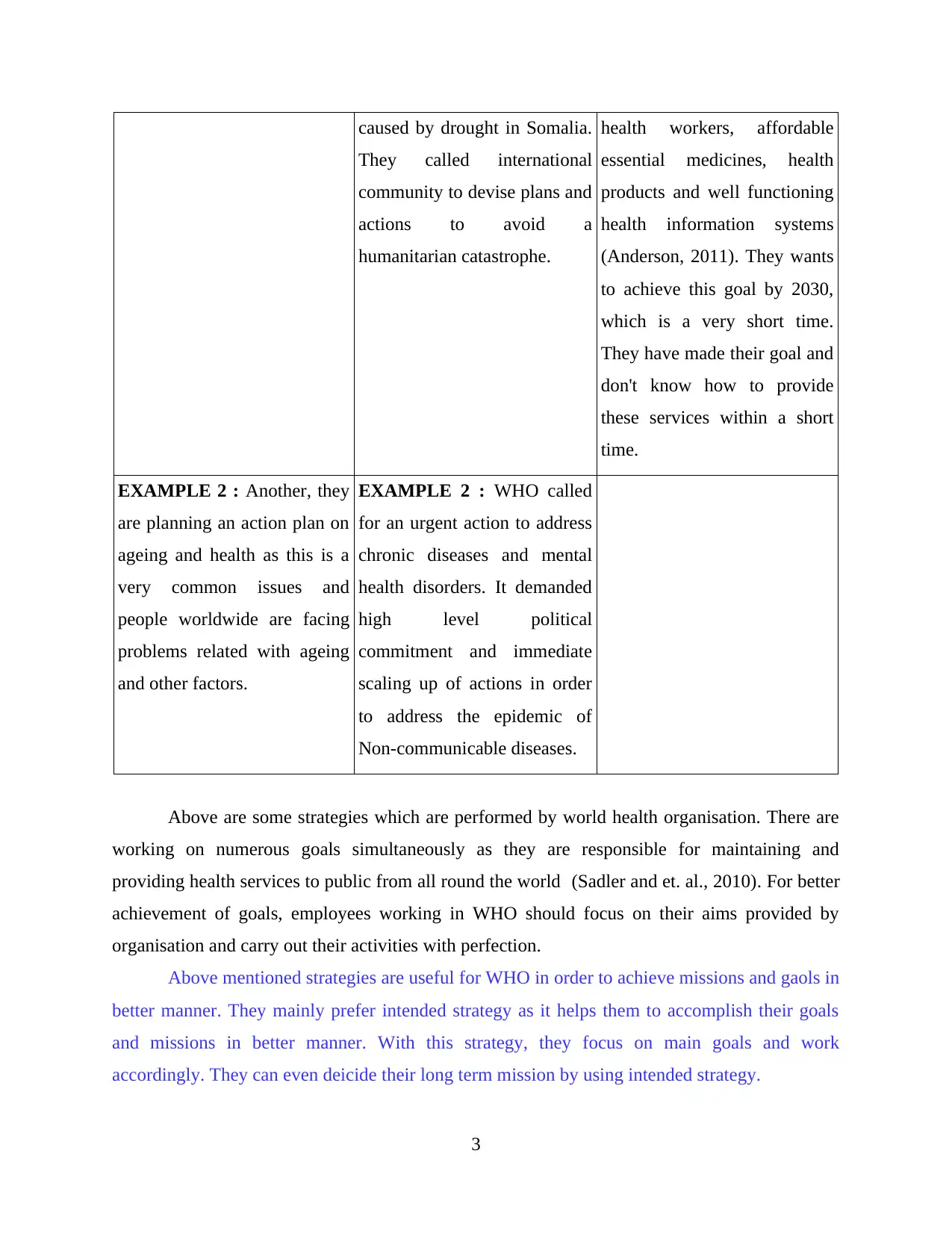
caused by drought in Somalia.
They called international
community to devise plans and
actions to avoid a
humanitarian catastrophe.
health workers, affordable
essential medicines, health
products and well functioning
health information systems
(Anderson, 2011). They wants
to achieve this goal by 2030,
which is a very short time.
They have made their goal and
don't know how to provide
these services within a short
time.
EXAMPLE 2 : Another, they
are planning an action plan on
ageing and health as this is a
very common issues and
people worldwide are facing
problems related with ageing
and other factors.
EXAMPLE 2 : WHO called
for an urgent action to address
chronic diseases and mental
health disorders. It demanded
high level political
commitment and immediate
scaling up of actions in order
to address the epidemic of
Non-communicable diseases.
Above are some strategies which are performed by world health organisation. There are
working on numerous goals simultaneously as they are responsible for maintaining and
providing health services to public from all round the world (Sadler and et. al., 2010). For better
achievement of goals, employees working in WHO should focus on their aims provided by
organisation and carry out their activities with perfection.
Above mentioned strategies are useful for WHO in order to achieve missions and gaols in
better manner. They mainly prefer intended strategy as it helps them to accomplish their goals
and missions in better manner. With this strategy, they focus on main goals and work
accordingly. They can even deicide their long term mission by using intended strategy.
3
They called international
community to devise plans and
actions to avoid a
humanitarian catastrophe.
health workers, affordable
essential medicines, health
products and well functioning
health information systems
(Anderson, 2011). They wants
to achieve this goal by 2030,
which is a very short time.
They have made their goal and
don't know how to provide
these services within a short
time.
EXAMPLE 2 : Another, they
are planning an action plan on
ageing and health as this is a
very common issues and
people worldwide are facing
problems related with ageing
and other factors.
EXAMPLE 2 : WHO called
for an urgent action to address
chronic diseases and mental
health disorders. It demanded
high level political
commitment and immediate
scaling up of actions in order
to address the epidemic of
Non-communicable diseases.
Above are some strategies which are performed by world health organisation. There are
working on numerous goals simultaneously as they are responsible for maintaining and
providing health services to public from all round the world (Sadler and et. al., 2010). For better
achievement of goals, employees working in WHO should focus on their aims provided by
organisation and carry out their activities with perfection.
Above mentioned strategies are useful for WHO in order to achieve missions and gaols in
better manner. They mainly prefer intended strategy as it helps them to accomplish their goals
and missions in better manner. With this strategy, they focus on main goals and work
accordingly. They can even deicide their long term mission by using intended strategy.
3
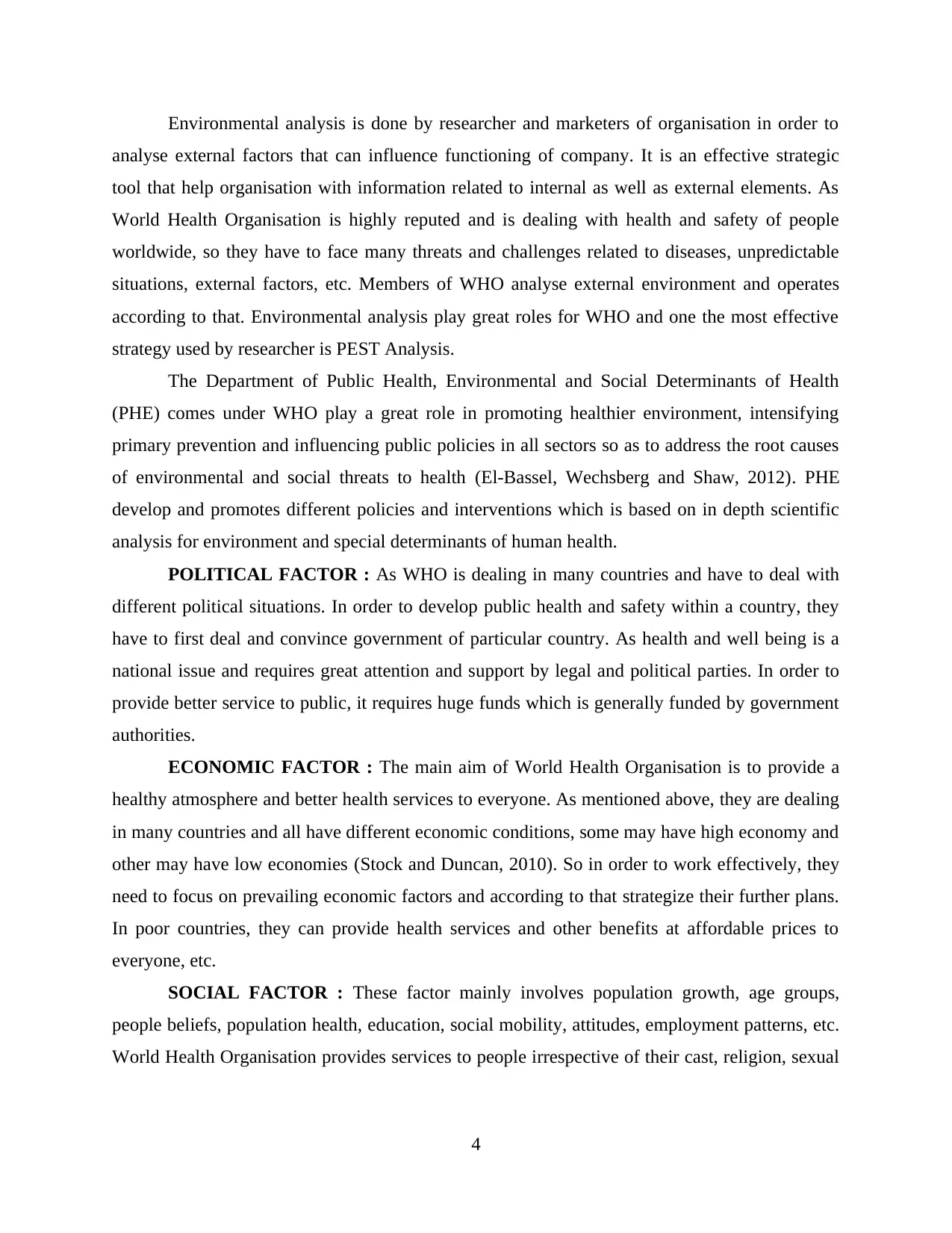
Environmental analysis is done by researcher and marketers of organisation in order to
analyse external factors that can influence functioning of company. It is an effective strategic
tool that help organisation with information related to internal as well as external elements. As
World Health Organisation is highly reputed and is dealing with health and safety of people
worldwide, so they have to face many threats and challenges related to diseases, unpredictable
situations, external factors, etc. Members of WHO analyse external environment and operates
according to that. Environmental analysis play great roles for WHO and one the most effective
strategy used by researcher is PEST Analysis.
The Department of Public Health, Environmental and Social Determinants of Health
(PHE) comes under WHO play a great role in promoting healthier environment, intensifying
primary prevention and influencing public policies in all sectors so as to address the root causes
of environmental and social threats to health (El-Bassel, Wechsberg and Shaw, 2012). PHE
develop and promotes different policies and interventions which is based on in depth scientific
analysis for environment and special determinants of human health.
POLITICAL FACTOR : As WHO is dealing in many countries and have to deal with
different political situations. In order to develop public health and safety within a country, they
have to first deal and convince government of particular country. As health and well being is a
national issue and requires great attention and support by legal and political parties. In order to
provide better service to public, it requires huge funds which is generally funded by government
authorities.
ECONOMIC FACTOR : The main aim of World Health Organisation is to provide a
healthy atmosphere and better health services to everyone. As mentioned above, they are dealing
in many countries and all have different economic conditions, some may have high economy and
other may have low economies (Stock and Duncan, 2010). So in order to work effectively, they
need to focus on prevailing economic factors and according to that strategize their further plans.
In poor countries, they can provide health services and other benefits at affordable prices to
everyone, etc.
SOCIAL FACTOR : These factor mainly involves population growth, age groups,
people beliefs, population health, education, social mobility, attitudes, employment patterns, etc.
World Health Organisation provides services to people irrespective of their cast, religion, sexual
4
analyse external factors that can influence functioning of company. It is an effective strategic
tool that help organisation with information related to internal as well as external elements. As
World Health Organisation is highly reputed and is dealing with health and safety of people
worldwide, so they have to face many threats and challenges related to diseases, unpredictable
situations, external factors, etc. Members of WHO analyse external environment and operates
according to that. Environmental analysis play great roles for WHO and one the most effective
strategy used by researcher is PEST Analysis.
The Department of Public Health, Environmental and Social Determinants of Health
(PHE) comes under WHO play a great role in promoting healthier environment, intensifying
primary prevention and influencing public policies in all sectors so as to address the root causes
of environmental and social threats to health (El-Bassel, Wechsberg and Shaw, 2012). PHE
develop and promotes different policies and interventions which is based on in depth scientific
analysis for environment and special determinants of human health.
POLITICAL FACTOR : As WHO is dealing in many countries and have to deal with
different political situations. In order to develop public health and safety within a country, they
have to first deal and convince government of particular country. As health and well being is a
national issue and requires great attention and support by legal and political parties. In order to
provide better service to public, it requires huge funds which is generally funded by government
authorities.
ECONOMIC FACTOR : The main aim of World Health Organisation is to provide a
healthy atmosphere and better health services to everyone. As mentioned above, they are dealing
in many countries and all have different economic conditions, some may have high economy and
other may have low economies (Stock and Duncan, 2010). So in order to work effectively, they
need to focus on prevailing economic factors and according to that strategize their further plans.
In poor countries, they can provide health services and other benefits at affordable prices to
everyone, etc.
SOCIAL FACTOR : These factor mainly involves population growth, age groups,
people beliefs, population health, education, social mobility, attitudes, employment patterns, etc.
World Health Organisation provides services to people irrespective of their cast, religion, sexual
4
⊘ This is a preview!⊘
Do you want full access?
Subscribe today to unlock all pages.

Trusted by 1+ million students worldwide
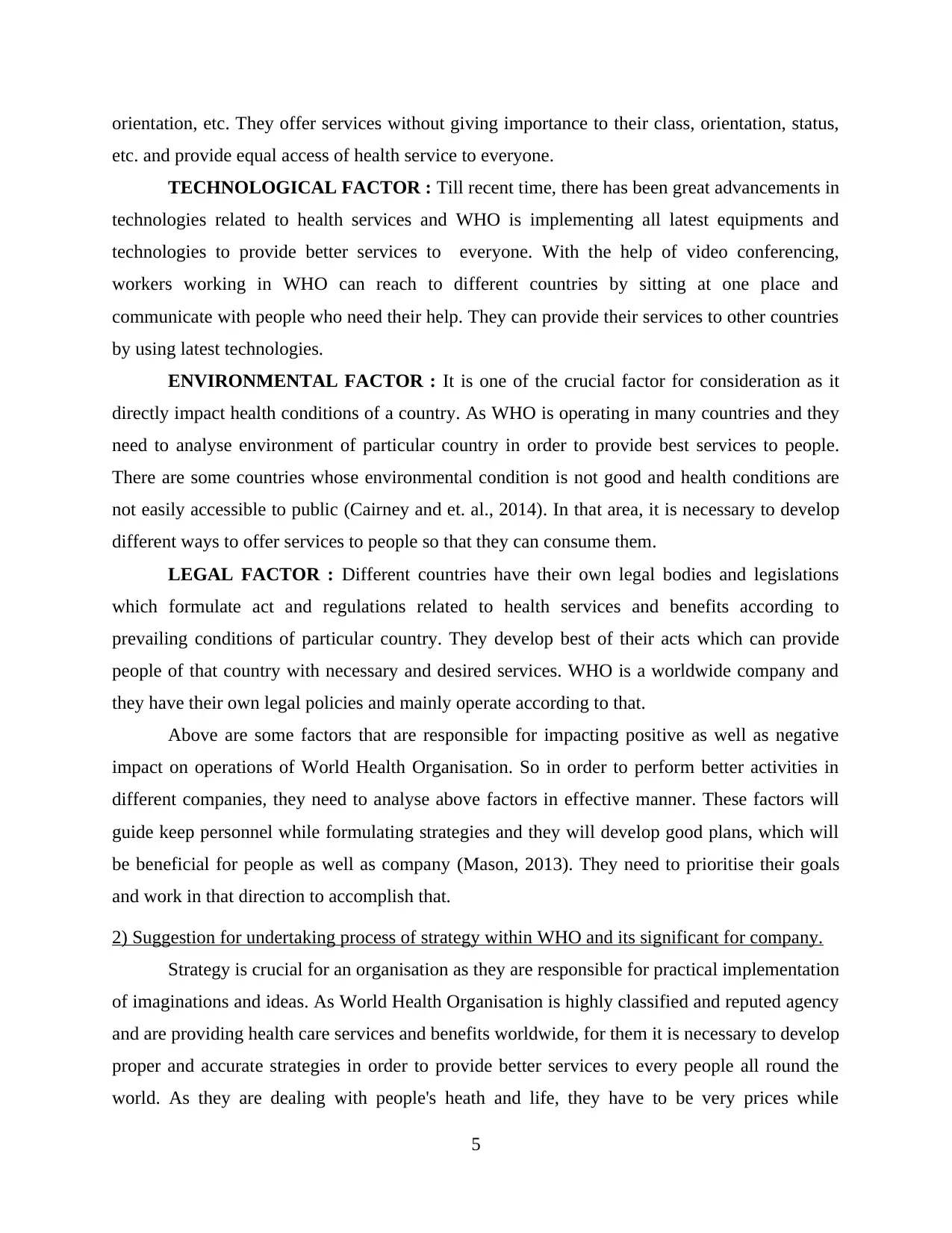
orientation, etc. They offer services without giving importance to their class, orientation, status,
etc. and provide equal access of health service to everyone.
TECHNOLOGICAL FACTOR : Till recent time, there has been great advancements in
technologies related to health services and WHO is implementing all latest equipments and
technologies to provide better services to everyone. With the help of video conferencing,
workers working in WHO can reach to different countries by sitting at one place and
communicate with people who need their help. They can provide their services to other countries
by using latest technologies.
ENVIRONMENTAL FACTOR : It is one of the crucial factor for consideration as it
directly impact health conditions of a country. As WHO is operating in many countries and they
need to analyse environment of particular country in order to provide best services to people.
There are some countries whose environmental condition is not good and health conditions are
not easily accessible to public (Cairney and et. al., 2014). In that area, it is necessary to develop
different ways to offer services to people so that they can consume them.
LEGAL FACTOR : Different countries have their own legal bodies and legislations
which formulate act and regulations related to health services and benefits according to
prevailing conditions of particular country. They develop best of their acts which can provide
people of that country with necessary and desired services. WHO is a worldwide company and
they have their own legal policies and mainly operate according to that.
Above are some factors that are responsible for impacting positive as well as negative
impact on operations of World Health Organisation. So in order to perform better activities in
different companies, they need to analyse above factors in effective manner. These factors will
guide keep personnel while formulating strategies and they will develop good plans, which will
be beneficial for people as well as company (Mason, 2013). They need to prioritise their goals
and work in that direction to accomplish that.
2) Suggestion for undertaking process of strategy within WHO and its significant for company.
Strategy is crucial for an organisation as they are responsible for practical implementation
of imaginations and ideas. As World Health Organisation is highly classified and reputed agency
and are providing health care services and benefits worldwide, for them it is necessary to develop
proper and accurate strategies in order to provide better services to every people all round the
world. As they are dealing with people's heath and life, they have to be very prices while
5
etc. and provide equal access of health service to everyone.
TECHNOLOGICAL FACTOR : Till recent time, there has been great advancements in
technologies related to health services and WHO is implementing all latest equipments and
technologies to provide better services to everyone. With the help of video conferencing,
workers working in WHO can reach to different countries by sitting at one place and
communicate with people who need their help. They can provide their services to other countries
by using latest technologies.
ENVIRONMENTAL FACTOR : It is one of the crucial factor for consideration as it
directly impact health conditions of a country. As WHO is operating in many countries and they
need to analyse environment of particular country in order to provide best services to people.
There are some countries whose environmental condition is not good and health conditions are
not easily accessible to public (Cairney and et. al., 2014). In that area, it is necessary to develop
different ways to offer services to people so that they can consume them.
LEGAL FACTOR : Different countries have their own legal bodies and legislations
which formulate act and regulations related to health services and benefits according to
prevailing conditions of particular country. They develop best of their acts which can provide
people of that country with necessary and desired services. WHO is a worldwide company and
they have their own legal policies and mainly operate according to that.
Above are some factors that are responsible for impacting positive as well as negative
impact on operations of World Health Organisation. So in order to perform better activities in
different companies, they need to analyse above factors in effective manner. These factors will
guide keep personnel while formulating strategies and they will develop good plans, which will
be beneficial for people as well as company (Mason, 2013). They need to prioritise their goals
and work in that direction to accomplish that.
2) Suggestion for undertaking process of strategy within WHO and its significant for company.
Strategy is crucial for an organisation as they are responsible for practical implementation
of imaginations and ideas. As World Health Organisation is highly classified and reputed agency
and are providing health care services and benefits worldwide, for them it is necessary to develop
proper and accurate strategies in order to provide better services to every people all round the
world. As they are dealing with people's heath and life, they have to be very prices while
5
Paraphrase This Document
Need a fresh take? Get an instant paraphrase of this document with our AI Paraphraser
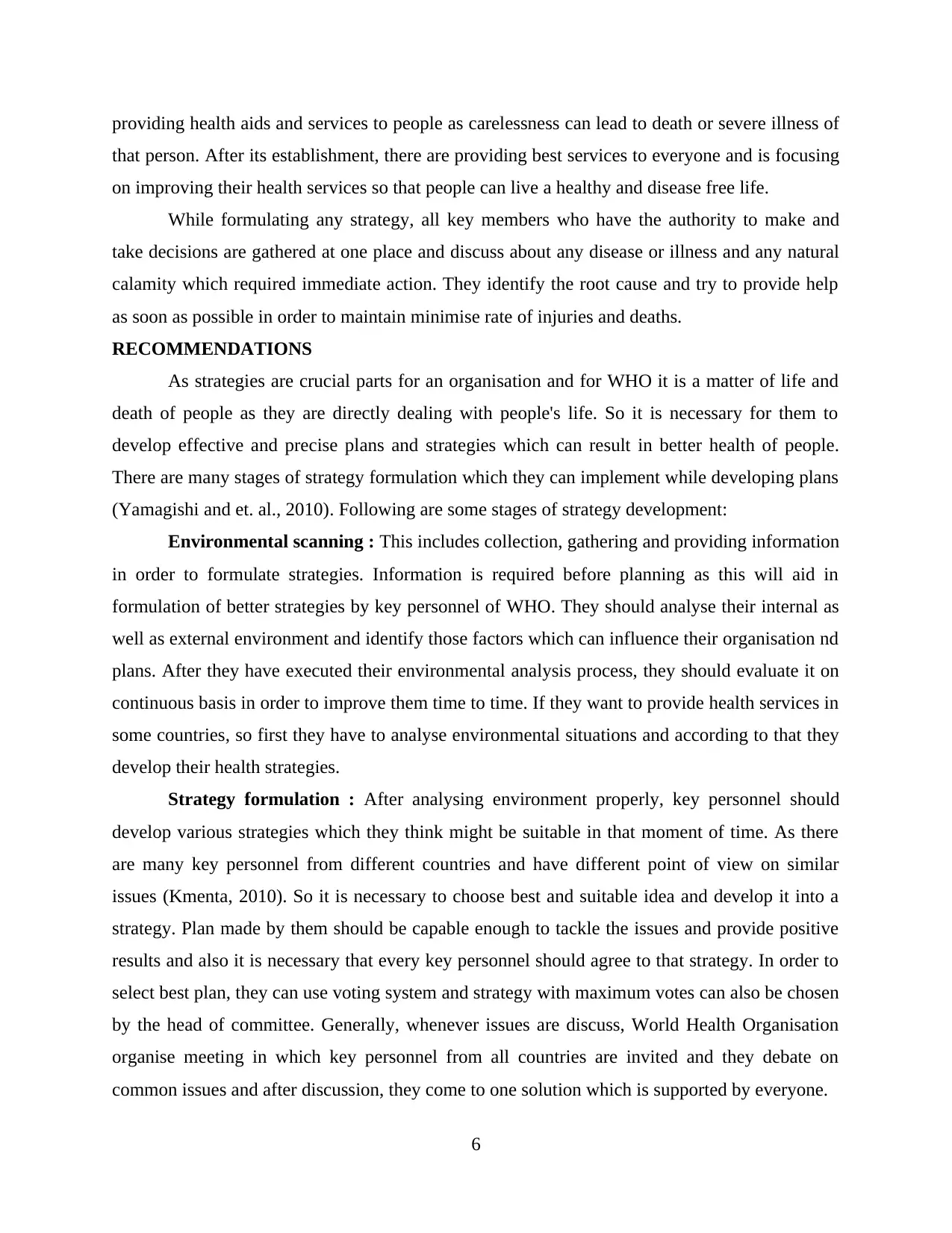
providing health aids and services to people as carelessness can lead to death or severe illness of
that person. After its establishment, there are providing best services to everyone and is focusing
on improving their health services so that people can live a healthy and disease free life.
While formulating any strategy, all key members who have the authority to make and
take decisions are gathered at one place and discuss about any disease or illness and any natural
calamity which required immediate action. They identify the root cause and try to provide help
as soon as possible in order to maintain minimise rate of injuries and deaths.
RECOMMENDATIONS
As strategies are crucial parts for an organisation and for WHO it is a matter of life and
death of people as they are directly dealing with people's life. So it is necessary for them to
develop effective and precise plans and strategies which can result in better health of people.
There are many stages of strategy formulation which they can implement while developing plans
(Yamagishi and et. al., 2010). Following are some stages of strategy development:
Environmental scanning : This includes collection, gathering and providing information
in order to formulate strategies. Information is required before planning as this will aid in
formulation of better strategies by key personnel of WHO. They should analyse their internal as
well as external environment and identify those factors which can influence their organisation nd
plans. After they have executed their environmental analysis process, they should evaluate it on
continuous basis in order to improve them time to time. If they want to provide health services in
some countries, so first they have to analyse environmental situations and according to that they
develop their health strategies.
Strategy formulation : After analysing environment properly, key personnel should
develop various strategies which they think might be suitable in that moment of time. As there
are many key personnel from different countries and have different point of view on similar
issues (Kmenta, 2010). So it is necessary to choose best and suitable idea and develop it into a
strategy. Plan made by them should be capable enough to tackle the issues and provide positive
results and also it is necessary that every key personnel should agree to that strategy. In order to
select best plan, they can use voting system and strategy with maximum votes can also be chosen
by the head of committee. Generally, whenever issues are discuss, World Health Organisation
organise meeting in which key personnel from all countries are invited and they debate on
common issues and after discussion, they come to one solution which is supported by everyone.
6
that person. After its establishment, there are providing best services to everyone and is focusing
on improving their health services so that people can live a healthy and disease free life.
While formulating any strategy, all key members who have the authority to make and
take decisions are gathered at one place and discuss about any disease or illness and any natural
calamity which required immediate action. They identify the root cause and try to provide help
as soon as possible in order to maintain minimise rate of injuries and deaths.
RECOMMENDATIONS
As strategies are crucial parts for an organisation and for WHO it is a matter of life and
death of people as they are directly dealing with people's life. So it is necessary for them to
develop effective and precise plans and strategies which can result in better health of people.
There are many stages of strategy formulation which they can implement while developing plans
(Yamagishi and et. al., 2010). Following are some stages of strategy development:
Environmental scanning : This includes collection, gathering and providing information
in order to formulate strategies. Information is required before planning as this will aid in
formulation of better strategies by key personnel of WHO. They should analyse their internal as
well as external environment and identify those factors which can influence their organisation nd
plans. After they have executed their environmental analysis process, they should evaluate it on
continuous basis in order to improve them time to time. If they want to provide health services in
some countries, so first they have to analyse environmental situations and according to that they
develop their health strategies.
Strategy formulation : After analysing environment properly, key personnel should
develop various strategies which they think might be suitable in that moment of time. As there
are many key personnel from different countries and have different point of view on similar
issues (Kmenta, 2010). So it is necessary to choose best and suitable idea and develop it into a
strategy. Plan made by them should be capable enough to tackle the issues and provide positive
results and also it is necessary that every key personnel should agree to that strategy. In order to
select best plan, they can use voting system and strategy with maximum votes can also be chosen
by the head of committee. Generally, whenever issues are discuss, World Health Organisation
organise meeting in which key personnel from all countries are invited and they debate on
common issues and after discussion, they come to one solution which is supported by everyone.
6
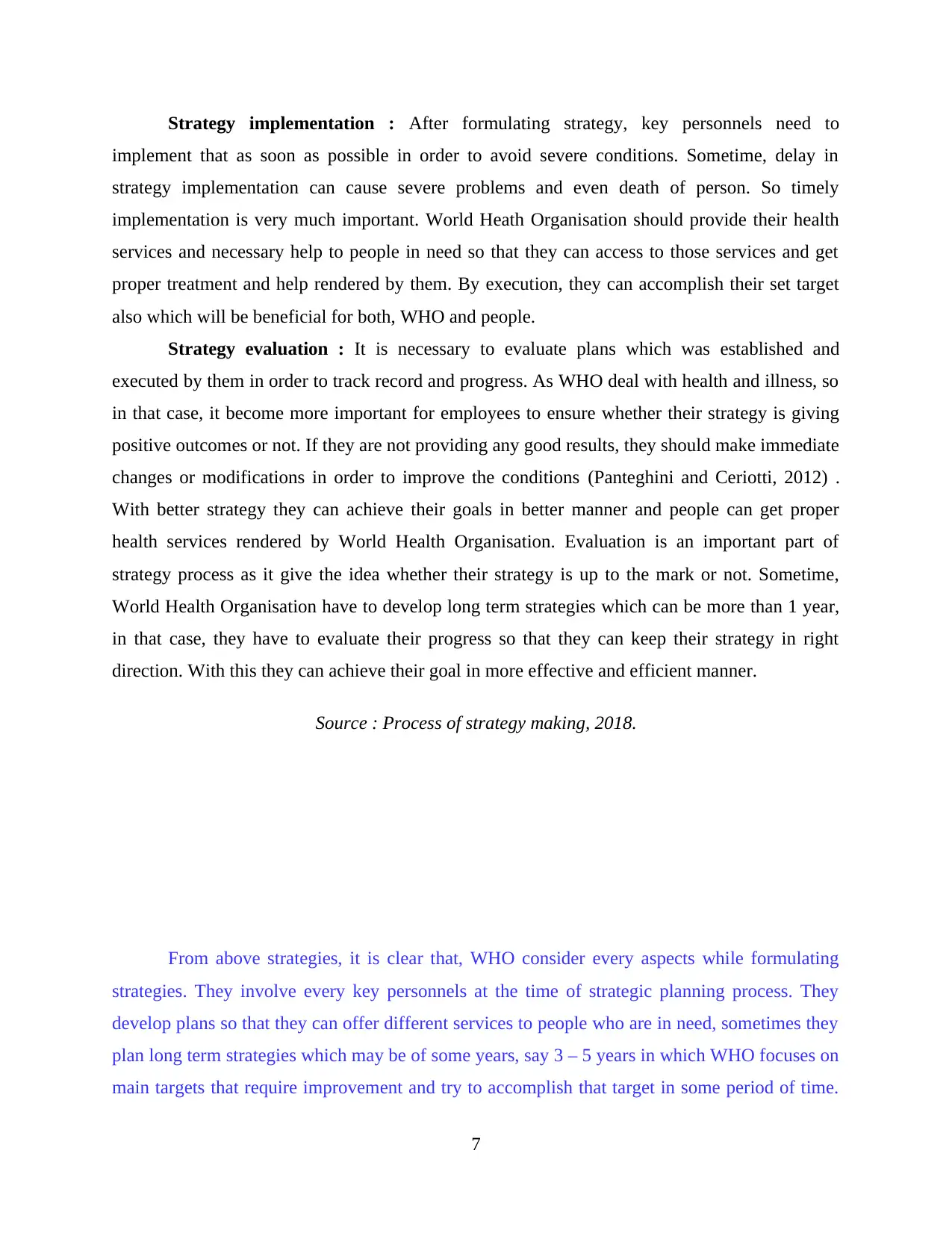
Strategy implementation : After formulating strategy, key personnels need to
implement that as soon as possible in order to avoid severe conditions. Sometime, delay in
strategy implementation can cause severe problems and even death of person. So timely
implementation is very much important. World Heath Organisation should provide their health
services and necessary help to people in need so that they can access to those services and get
proper treatment and help rendered by them. By execution, they can accomplish their set target
also which will be beneficial for both, WHO and people.
Strategy evaluation : It is necessary to evaluate plans which was established and
executed by them in order to track record and progress. As WHO deal with health and illness, so
in that case, it become more important for employees to ensure whether their strategy is giving
positive outcomes or not. If they are not providing any good results, they should make immediate
changes or modifications in order to improve the conditions (Panteghini and Ceriotti, 2012) .
With better strategy they can achieve their goals in better manner and people can get proper
health services rendered by World Health Organisation. Evaluation is an important part of
strategy process as it give the idea whether their strategy is up to the mark or not. Sometime,
World Health Organisation have to develop long term strategies which can be more than 1 year,
in that case, they have to evaluate their progress so that they can keep their strategy in right
direction. With this they can achieve their goal in more effective and efficient manner.
From above strategies, it is clear that, WHO consider every aspects while formulating
strategies. They involve every key personnels at the time of strategic planning process. They
develop plans so that they can offer different services to people who are in need, sometimes they
plan long term strategies which may be of some years, say 3 – 5 years in which WHO focuses on
main targets that require improvement and try to accomplish that target in some period of time.
7
Source : Process of strategy making, 2018.
implement that as soon as possible in order to avoid severe conditions. Sometime, delay in
strategy implementation can cause severe problems and even death of person. So timely
implementation is very much important. World Heath Organisation should provide their health
services and necessary help to people in need so that they can access to those services and get
proper treatment and help rendered by them. By execution, they can accomplish their set target
also which will be beneficial for both, WHO and people.
Strategy evaluation : It is necessary to evaluate plans which was established and
executed by them in order to track record and progress. As WHO deal with health and illness, so
in that case, it become more important for employees to ensure whether their strategy is giving
positive outcomes or not. If they are not providing any good results, they should make immediate
changes or modifications in order to improve the conditions (Panteghini and Ceriotti, 2012) .
With better strategy they can achieve their goals in better manner and people can get proper
health services rendered by World Health Organisation. Evaluation is an important part of
strategy process as it give the idea whether their strategy is up to the mark or not. Sometime,
World Health Organisation have to develop long term strategies which can be more than 1 year,
in that case, they have to evaluate their progress so that they can keep their strategy in right
direction. With this they can achieve their goal in more effective and efficient manner.
From above strategies, it is clear that, WHO consider every aspects while formulating
strategies. They involve every key personnels at the time of strategic planning process. They
develop plans so that they can offer different services to people who are in need, sometimes they
plan long term strategies which may be of some years, say 3 – 5 years in which WHO focuses on
main targets that require improvement and try to accomplish that target in some period of time.
7
Source : Process of strategy making, 2018.
⊘ This is a preview!⊘
Do you want full access?
Subscribe today to unlock all pages.

Trusted by 1+ million students worldwide
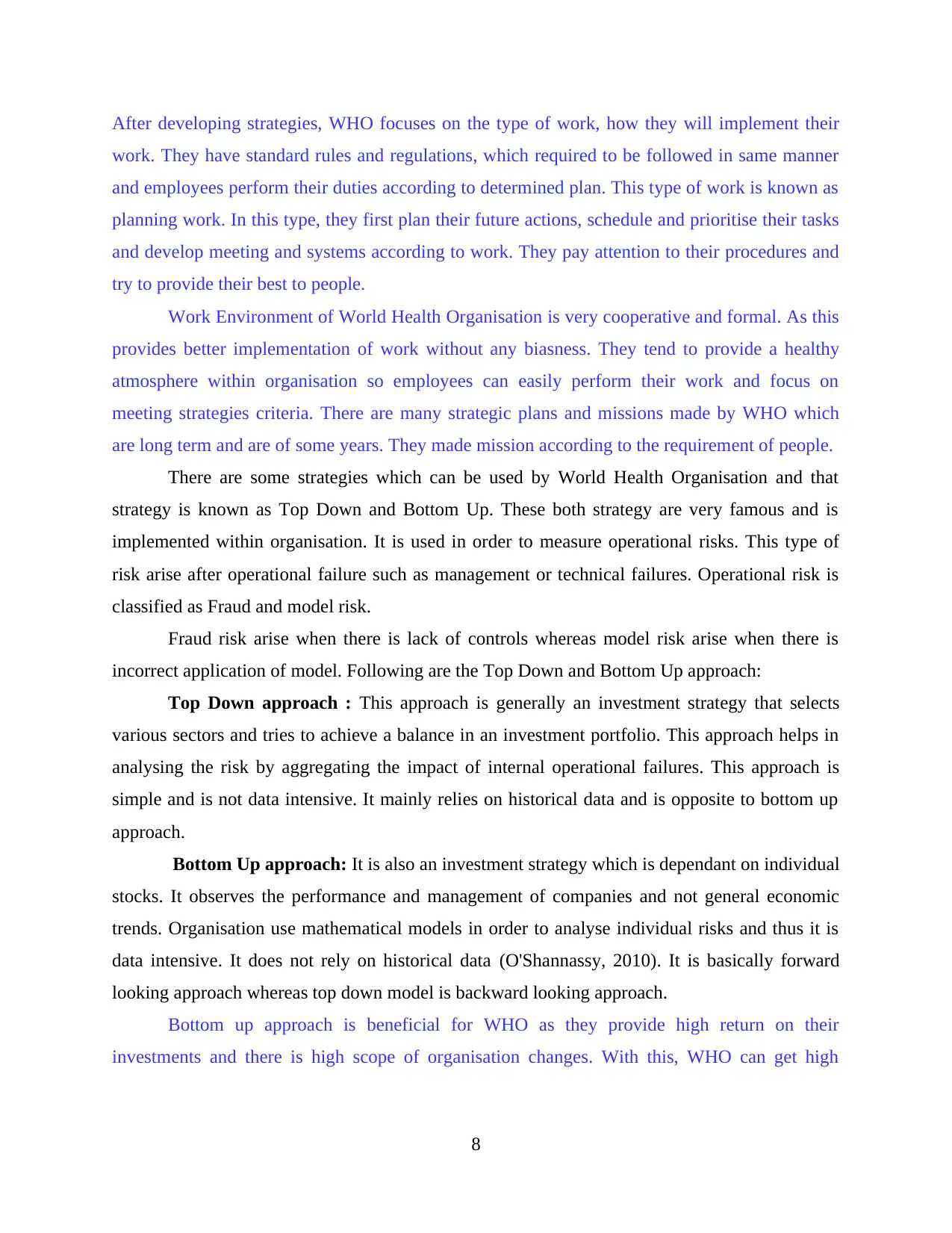
After developing strategies, WHO focuses on the type of work, how they will implement their
work. They have standard rules and regulations, which required to be followed in same manner
and employees perform their duties according to determined plan. This type of work is known as
planning work. In this type, they first plan their future actions, schedule and prioritise their tasks
and develop meeting and systems according to work. They pay attention to their procedures and
try to provide their best to people.
Work Environment of World Health Organisation is very cooperative and formal. As this
provides better implementation of work without any biasness. They tend to provide a healthy
atmosphere within organisation so employees can easily perform their work and focus on
meeting strategies criteria. There are many strategic plans and missions made by WHO which
are long term and are of some years. They made mission according to the requirement of people.
There are some strategies which can be used by World Health Organisation and that
strategy is known as Top Down and Bottom Up. These both strategy are very famous and is
implemented within organisation. It is used in order to measure operational risks. This type of
risk arise after operational failure such as management or technical failures. Operational risk is
classified as Fraud and model risk.
Fraud risk arise when there is lack of controls whereas model risk arise when there is
incorrect application of model. Following are the Top Down and Bottom Up approach:
Top Down approach : This approach is generally an investment strategy that selects
various sectors and tries to achieve a balance in an investment portfolio. This approach helps in
analysing the risk by aggregating the impact of internal operational failures. This approach is
simple and is not data intensive. It mainly relies on historical data and is opposite to bottom up
approach.
Bottom Up approach: It is also an investment strategy which is dependant on individual
stocks. It observes the performance and management of companies and not general economic
trends. Organisation use mathematical models in order to analyse individual risks and thus it is
data intensive. It does not rely on historical data (O'Shannassy, 2010). It is basically forward
looking approach whereas top down model is backward looking approach.
Bottom up approach is beneficial for WHO as they provide high return on their
investments and there is high scope of organisation changes. With this, WHO can get high
8
work. They have standard rules and regulations, which required to be followed in same manner
and employees perform their duties according to determined plan. This type of work is known as
planning work. In this type, they first plan their future actions, schedule and prioritise their tasks
and develop meeting and systems according to work. They pay attention to their procedures and
try to provide their best to people.
Work Environment of World Health Organisation is very cooperative and formal. As this
provides better implementation of work without any biasness. They tend to provide a healthy
atmosphere within organisation so employees can easily perform their work and focus on
meeting strategies criteria. There are many strategic plans and missions made by WHO which
are long term and are of some years. They made mission according to the requirement of people.
There are some strategies which can be used by World Health Organisation and that
strategy is known as Top Down and Bottom Up. These both strategy are very famous and is
implemented within organisation. It is used in order to measure operational risks. This type of
risk arise after operational failure such as management or technical failures. Operational risk is
classified as Fraud and model risk.
Fraud risk arise when there is lack of controls whereas model risk arise when there is
incorrect application of model. Following are the Top Down and Bottom Up approach:
Top Down approach : This approach is generally an investment strategy that selects
various sectors and tries to achieve a balance in an investment portfolio. This approach helps in
analysing the risk by aggregating the impact of internal operational failures. This approach is
simple and is not data intensive. It mainly relies on historical data and is opposite to bottom up
approach.
Bottom Up approach: It is also an investment strategy which is dependant on individual
stocks. It observes the performance and management of companies and not general economic
trends. Organisation use mathematical models in order to analyse individual risks and thus it is
data intensive. It does not rely on historical data (O'Shannassy, 2010). It is basically forward
looking approach whereas top down model is backward looking approach.
Bottom up approach is beneficial for WHO as they provide high return on their
investments and there is high scope of organisation changes. With this, WHO can get high
8
Paraphrase This Document
Need a fresh take? Get an instant paraphrase of this document with our AI Paraphraser
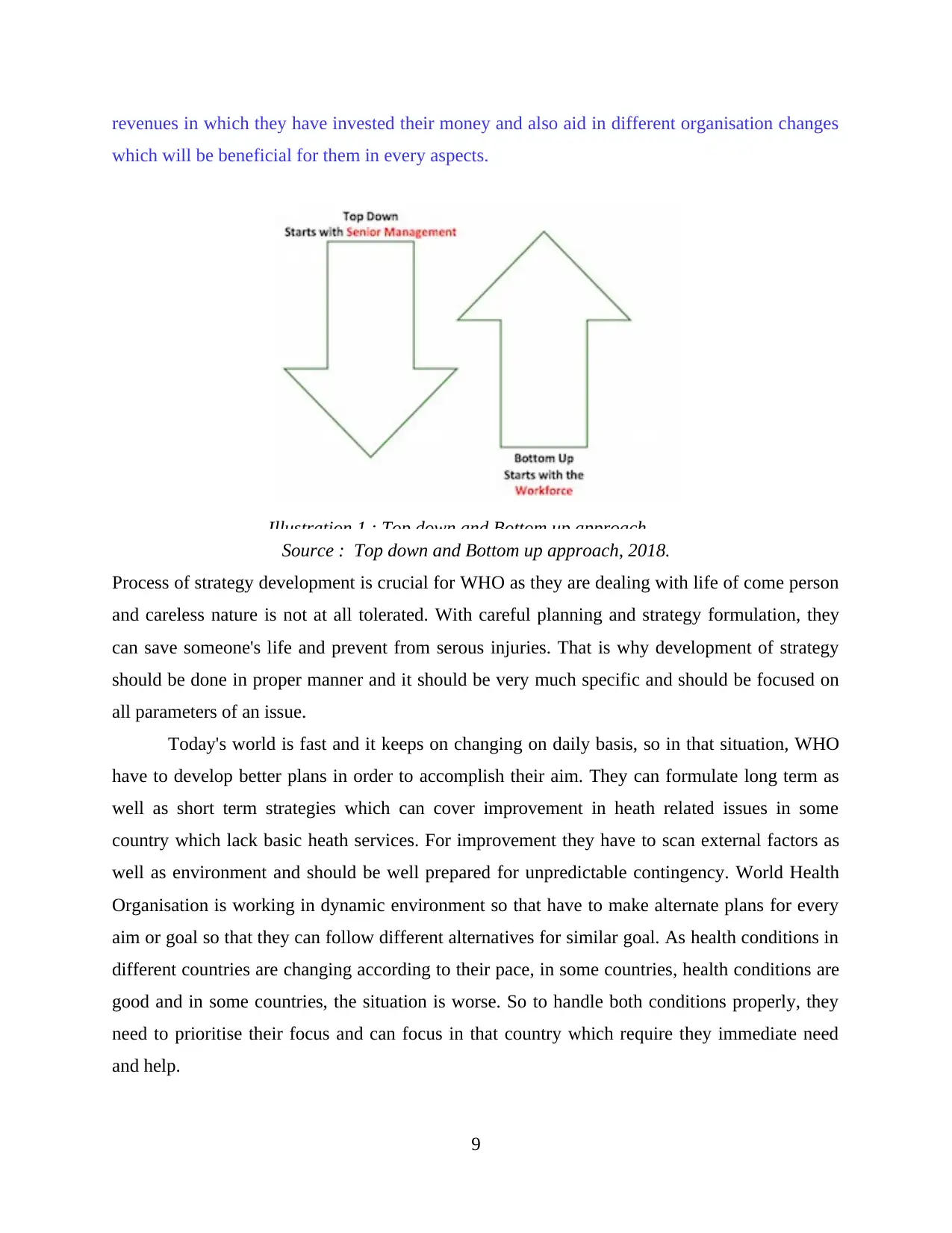
revenues in which they have invested their money and also aid in different organisation changes
which will be beneficial for them in every aspects.
Source : Top down and Bottom up approach, 2018.
Process of strategy development is crucial for WHO as they are dealing with life of come person
and careless nature is not at all tolerated. With careful planning and strategy formulation, they
can save someone's life and prevent from serous injuries. That is why development of strategy
should be done in proper manner and it should be very much specific and should be focused on
all parameters of an issue.
Today's world is fast and it keeps on changing on daily basis, so in that situation, WHO
have to develop better plans in order to accomplish their aim. They can formulate long term as
well as short term strategies which can cover improvement in heath related issues in some
country which lack basic heath services. For improvement they have to scan external factors as
well as environment and should be well prepared for unpredictable contingency. World Health
Organisation is working in dynamic environment so that have to make alternate plans for every
aim or goal so that they can follow different alternatives for similar goal. As health conditions in
different countries are changing according to their pace, in some countries, health conditions are
good and in some countries, the situation is worse. So to handle both conditions properly, they
need to prioritise their focus and can focus in that country which require they immediate need
and help.
9
Illustration 1 : Top down and Bottom up approach
which will be beneficial for them in every aspects.
Source : Top down and Bottom up approach, 2018.
Process of strategy development is crucial for WHO as they are dealing with life of come person
and careless nature is not at all tolerated. With careful planning and strategy formulation, they
can save someone's life and prevent from serous injuries. That is why development of strategy
should be done in proper manner and it should be very much specific and should be focused on
all parameters of an issue.
Today's world is fast and it keeps on changing on daily basis, so in that situation, WHO
have to develop better plans in order to accomplish their aim. They can formulate long term as
well as short term strategies which can cover improvement in heath related issues in some
country which lack basic heath services. For improvement they have to scan external factors as
well as environment and should be well prepared for unpredictable contingency. World Health
Organisation is working in dynamic environment so that have to make alternate plans for every
aim or goal so that they can follow different alternatives for similar goal. As health conditions in
different countries are changing according to their pace, in some countries, health conditions are
good and in some countries, the situation is worse. So to handle both conditions properly, they
need to prioritise their focus and can focus in that country which require they immediate need
and help.
9
Illustration 1 : Top down and Bottom up approach
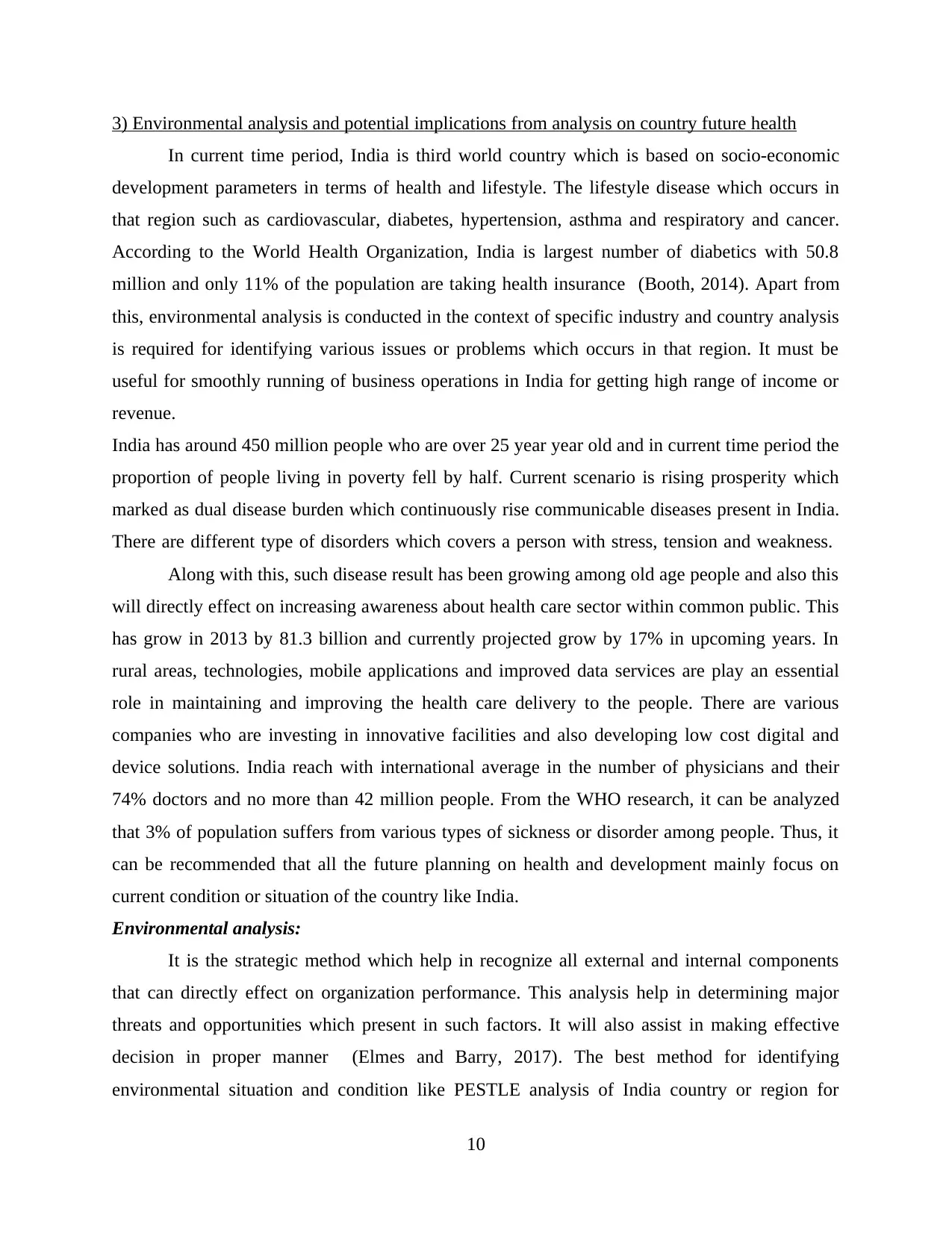
3) Environmental analysis and potential implications from analysis on country future health
In current time period, India is third world country which is based on socio-economic
development parameters in terms of health and lifestyle. The lifestyle disease which occurs in
that region such as cardiovascular, diabetes, hypertension, asthma and respiratory and cancer.
According to the World Health Organization, India is largest number of diabetics with 50.8
million and only 11% of the population are taking health insurance (Booth, 2014). Apart from
this, environmental analysis is conducted in the context of specific industry and country analysis
is required for identifying various issues or problems which occurs in that region. It must be
useful for smoothly running of business operations in India for getting high range of income or
revenue.
India has around 450 million people who are over 25 year year old and in current time period the
proportion of people living in poverty fell by half. Current scenario is rising prosperity which
marked as dual disease burden which continuously rise communicable diseases present in India.
There are different type of disorders which covers a person with stress, tension and weakness.
Along with this, such disease result has been growing among old age people and also this
will directly effect on increasing awareness about health care sector within common public. This
has grow in 2013 by 81.3 billion and currently projected grow by 17% in upcoming years. In
rural areas, technologies, mobile applications and improved data services are play an essential
role in maintaining and improving the health care delivery to the people. There are various
companies who are investing in innovative facilities and also developing low cost digital and
device solutions. India reach with international average in the number of physicians and their
74% doctors and no more than 42 million people. From the WHO research, it can be analyzed
that 3% of population suffers from various types of sickness or disorder among people. Thus, it
can be recommended that all the future planning on health and development mainly focus on
current condition or situation of the country like India.
Environmental analysis:
It is the strategic method which help in recognize all external and internal components
that can directly effect on organization performance. This analysis help in determining major
threats and opportunities which present in such factors. It will also assist in making effective
decision in proper manner (Elmes and Barry, 2017). The best method for identifying
environmental situation and condition like PESTLE analysis of India country or region for
10
In current time period, India is third world country which is based on socio-economic
development parameters in terms of health and lifestyle. The lifestyle disease which occurs in
that region such as cardiovascular, diabetes, hypertension, asthma and respiratory and cancer.
According to the World Health Organization, India is largest number of diabetics with 50.8
million and only 11% of the population are taking health insurance (Booth, 2014). Apart from
this, environmental analysis is conducted in the context of specific industry and country analysis
is required for identifying various issues or problems which occurs in that region. It must be
useful for smoothly running of business operations in India for getting high range of income or
revenue.
India has around 450 million people who are over 25 year year old and in current time period the
proportion of people living in poverty fell by half. Current scenario is rising prosperity which
marked as dual disease burden which continuously rise communicable diseases present in India.
There are different type of disorders which covers a person with stress, tension and weakness.
Along with this, such disease result has been growing among old age people and also this
will directly effect on increasing awareness about health care sector within common public. This
has grow in 2013 by 81.3 billion and currently projected grow by 17% in upcoming years. In
rural areas, technologies, mobile applications and improved data services are play an essential
role in maintaining and improving the health care delivery to the people. There are various
companies who are investing in innovative facilities and also developing low cost digital and
device solutions. India reach with international average in the number of physicians and their
74% doctors and no more than 42 million people. From the WHO research, it can be analyzed
that 3% of population suffers from various types of sickness or disorder among people. Thus, it
can be recommended that all the future planning on health and development mainly focus on
current condition or situation of the country like India.
Environmental analysis:
It is the strategic method which help in recognize all external and internal components
that can directly effect on organization performance. This analysis help in determining major
threats and opportunities which present in such factors. It will also assist in making effective
decision in proper manner (Elmes and Barry, 2017). The best method for identifying
environmental situation and condition like PESTLE analysis of India country or region for
10
⊘ This is a preview!⊘
Do you want full access?
Subscribe today to unlock all pages.

Trusted by 1+ million students worldwide
1 out of 17
Related Documents
Your All-in-One AI-Powered Toolkit for Academic Success.
+13062052269
info@desklib.com
Available 24*7 on WhatsApp / Email
![[object Object]](/_next/static/media/star-bottom.7253800d.svg)
Unlock your academic potential
Copyright © 2020–2025 A2Z Services. All Rights Reserved. Developed and managed by ZUCOL.




